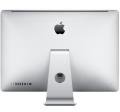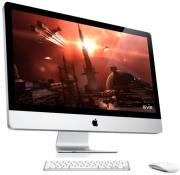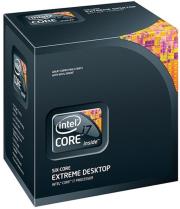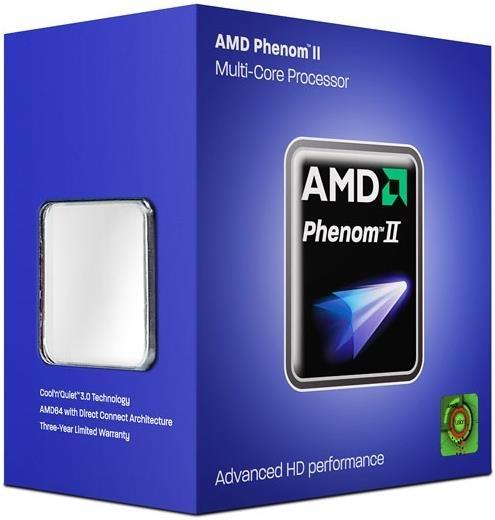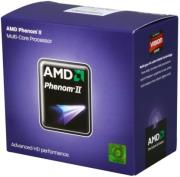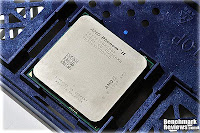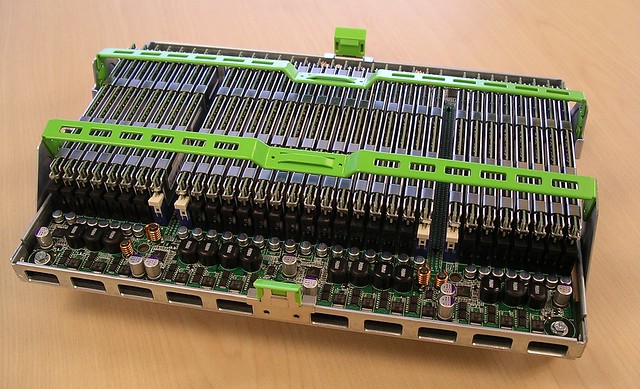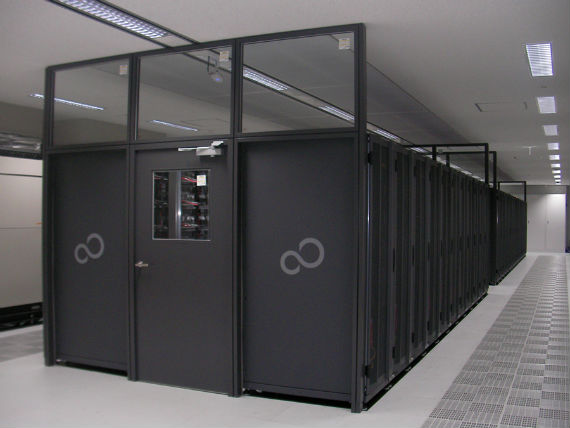Dream Machine 2010 was an exercise in PC building, overclocking, cooling—and patience
So, the desktop PC will become nothing more than a truck? Well, here’s your Mack truck, Mr. Jobs, filling your rear-view mirror on Interstate 80 as you try to get that tablet-sized, Flash-less-powered toy out of the fast lane. Oops, sorry about running you over.
Our take? If the future of the desktop PC is as a truck, it might as well be one hell of a fast and powerful truck. In building Dream Machine 2010, we embraced the notion of raw, wanton power. The result is a power rig capable of hauling a heavily threaded load uphill in top gear while other single- and dual-processor machines are barely chugging along in the slow lane with their hazard lights on.
 The Power Cube: Three turned out to be the magic number for this year's Dream: three GPUs, three radiators, three grills--even the 12 cores (and 24 threads) are divisible by three.
The Power Cube: Three turned out to be the magic number for this year's Dream: three GPUs, three radiators, three grills--even the 12 cores (and 24 threads) are divisible by three.At the onset of our Dream Machine project, we were concerned. 24 threads. Three videocards. 24GB of RAM. 4.4 terabytes of storage. Could we get it all to work together? And could we overclock the CPU and GPU enough to qualify as the fastest PC in the world? It took some wrangling, but we’re happy to reply with an emphatic YES. Even better, all this power has some astounding real-world benefits in multithreaded applications.
The simple paint job and tough-looking grills and fans on this year’s system complete the theme. This is not a system for the faint of heart. Read and enjoy.
Power Exposed
Want to know what's inside Dream Machine 2010? Here's the full monty

(click to enlarge)
Motherboard: EVGA Classified SR-2
This is the biggest motherboard we’ve ever seen

No one doubts that EVGA’s new Classified SR-2 is the mother of all motherboards. Sure, other boards will run dual Xeon processors
as well as 48GB of RAM, but in terms of physical size and configuration, there is literally nothing on Earth like the 13.6x15 inch SR-2. In sheer size, it dwarfs even the massive Intel Skulltrail motherboard that served as the foundation for
Dream Machine 2008. The girth of the board comes from EVGA’s proprietary HPTX formfactor, which can accommodate as many as nine expansion slots. However, given the SR-2’s
12 DIMM slots and two proc sockets (not to mention the nForce 200 bridge chips), this mobo has only seven slots. Fortunately, they’re all full-length x16 slots, with four running
x16 data rates.
The rest are x8 PCI-E 2.0. The board can accommodate an insane four double-wide graphics cards and even features
USB 3.0 and SATA6 ports to boot. In every way, the Classified SR-2 embodies this year’s theme of wanton power.
Graphics: EVGA GeForce GTX 480 SuperClocked
Water-cooling = overclocked tri-SLI
When we considered our graphics options, we had two configurations rattling around in our heads. Ultimately, EVGA’s GeForce GTX 480 SuperClocked cards won the honor. Sure, the Radeon HD 5970 is a hottie, but we’d be restricted to two cards in CrossFire X mode, which just doesn’t have the same panache as a tri-SLI GTX 480 setup. We briefly considered going with an obnoxious-sounding four GTX 480 cards, but nixed it. While decadent, we weren’t sure anything would scale to four GPUs. And it’s not like the tri-SLI cards were in danger of being overwhelmed. Once water-cooled and heavily overclocked to 910MHz (30 percent over a standard 480 card), the tri-SLI GTX 480 cards didn’t even creak under load. In the Unigine Heaven benchmark with everything maxed out, the EVGA GeForce GTX 480 cards belted out nearly 60fps. On our zero-point machine with a single Radeon HD 5970, we saw this same test stutter along at 3fps.
CPUs: Dual 3.3GHz Xeon X5680s Overclocked to 4GHz
Why Xeons? They give us 12 cores—and 24 threads

What’s the only thing better than a hexa-core Intel 3.3GHz Core i7-980X? Two hexa-cores. Sure, Intel’s 3.3GHz X5680 is technically a Xeon, but hardware geeks know that it’s really the multiprocessor version of the Core i7-980X. If you’re wondering why we didn’t just use two Core i7-980X chips—both versions are LGA1366 processors, after all—it’s because that’s impossible. The Xeon X5680 features two Quick Path Interfaces—one to communicate with the chipset and the other to talk to an additional CPU. A Core i7-980X intended for desktop use has the second QPI disabled at the factory to prevent its use in a multiprocessor setup. So, what do two ultra-pricey Xeon X5680 procs give us? An insane number of threads: 12 physical cores and an additional 12 virtual cores for a total of 24 threads. Besides giving us lightning-fast performance with highly threaded applications (think 42 to 79 percent faster than the fastest PCs today), this also gives us the ability to mega-multitask the hell out of anything.
Dual Processors Make Overclocking Twice as Challenging
It doesn’t really take a genius to overclock a Gulftown to reasonable levels. You crack open the BIOS, start cranking up the base clock (or bclock), and maybe add a little voltage to the CPU and the chipset. It’s not quite as easy with a dual-processor setup, however. In fact, it’s a bit daunting the first time you open up the BIOS on EVGA’s Classified SR-2 board. Umm, IOH QPI Signal… set that to, um, what again? Right.
Don’t take this as a knock against the SR-2 board. In fact, we’re tickled pink that it’s so overclocker-friendly, but the task still presents a challenge. Our goal was to reach a judicious clock speed—nothing too greedy. With the water-cooling in place, we were able to hit a stable 4GHz. We did this by disabling vdroop on both chips and increasing the core voltage to 1.35 volts, and by moving the CPU VTT up to 1.35. We actually underclocked the RAM to 1,066 and gave the chipset, or IOH, additional voltage of 1.45 volts. Digging around EVGA’s forum, we found that the company’s overclocking evangelist Shamino recommends an IOH QPI signal of -70 and -16. Our overclock was a simple bclock boost. By bumping up from the stock 133MHz to 160MHz, we achieved a very even and very stable 4GHz clock on both X5680 chips. With another 48 hours to futz around, we’re sure we could have reached the low- to mid-4GHz range, but deadlines are deadlines. Still, 4GHz on 12 cores of computing is nothing to scoff at.
We’d be remiss if we didn’t mention our GPU overclocking. Not everyone knows this, but MSI’s Afterburner utility now supports the GTX 480 and even lets you dial up the voltage. With our triple-radiator water-cooling system taming these nuclear graphics cards, we used Afterburner to speed up the cores of the three GPUs to an amazing 910MHz. We also increased GPU memory to 2,200MHz. This gave DM2010 a heavy advantage in GPU-bound graphics tests such as Heaven 2.0 and STALKER: CoP. —Gordon Mah Ung
Soundcard: Auzentech X-Fi Forte 7.1
This fully loaded card takes PC audio to places previously unheard of
Onboard audio has come a long way, but using the world’s best components to build a Dream Machine without also including a kick-ass soundcard is anathema to us. We immediately reached for Auzentech’s X-Fi Forte 7.1 this time around.
As much as we dig Creative’s X-Fi cards, Auzentech’s engineers pick up where Creative’s leave off. They use Creative’s awesome 20K2 PCI Express audio processor as a foundation, and then surround it with high-end (and upgradeable) op/amps; an AKM AK4396VF DAC with 24-bit resolution, sampling rates up to 192kHz, and a signal-to-noise ratio of 120dB; an integrated headphone amp; and a combo optical/coaxial stereo digital-audio output.
Using the X-Fi chipset means the card can deliver Creative’s entire suite of audio-processing tools, including the 24-bit Crystalizer, which we’ve found enhances even tracks we’ve ripped and losslessly encoded using FLAC. And for those games that take advantage of it, there’s support for Creative’s EAX 5.0.
Speakers: Bowers and Wilkins MM-1 Speakers and PV1 Subwoofer
Awesome speakers + ingenuity = dreamy audio
While demoing the incredible MM-1 computer speakers, a B&W rep told us how its engineers, during early product development, had used rejected prototypes in surround-sound configurations for movies and gaming. We immediately asked how we could do the same thing for the Dream Machine.
We wound up using three stereo pairs (front L/R, surround L/R, and one pair for the center) for our 7.1 configuration. The MM-1s are full-range speakers, but we threw B&W’s spectacular PV1 subwoofer into the mix for gut-punching bass.
Our configuration required a bit of creative cabling: The X-Fi Forte uses analog break-out cables, so we used the MM-1s’ analog aux inputs instead of their USB ports. And since the card outputs the center channel and low-frequency effects on the same cable, we used a cable with a 1/8-inch female jack on one end and two RCA male plugs at the other end. We connected the RCA plug carrying the LFE to the sub and the other to the center channel via an adapter.
Displays: Three HP ZR30w 30-inch LCDs
Screen real estate as far as the eye can see
We toyed with the idea of using a trio of Asus’s new VG236 3D displays with this year’s Dream Machine (three in 3D, get it?), but then HP dangled three of its brand-new ZR30w 30-inch LCDs in front of our eyes. The three 23-inch VG236 displays suddenly looked dwarfish sitting next to our massive aluminum cube computer.
The ZR30w isn’t just big, it’s an S-IPS panel (yay!) that uses 10 bits per pixel to produce 1.07 billion displayable colors. The ZR30w covers 100 percent of the sRGB color gamut and 99 percent of the Adobe RGB color gamut. As is common for displays this size, the ZR30w’s native resolution is 2560x1600 (a 16:10 aspect ratio). This monitor is obviously aimed at the pros, but we found its 7ms gray-to-gray refresh rate plenty fast enough to play Just Cause 2 and Bad Company 2 at a resolution of 7680x1600. Ooh-rah!
Optical Drive: Plextor B940SA
When price is no object, a Blu-ray burner makes sense
A Blu-ray burner is an extravagance, plain and simple. The drives are costly and so is the media. But this year’s Dream Machine demands the utmost capability at any cost, so we’re decking it out with Plextor’s B940SA. It’s got the highest available BD-R write rating at 12x. In real-world terms, that means we can fill a 25GB disc with data in a blistering 11 minutes. And that’s when we’re using Verbatim 4x media—this drive blows right past that speed rating, hitting 10x speeds during the course of its job. We can shave off even more time by using Sony or Panasonic media, which the drive is specially tuned for. Plus, the B940SA gives us the ability to watch Blu-ray movies, and what’s not to like about that?
Besides offering unparalleled Blu-ray prowess, the B940SA tackles all standard DVD chores with total proficiency. If there’s a more all-around capable optical drive to be had, we don’t know of it.
Chassis: Mountain Mods U2-UFO
Gigantic and fully customizable, this is the ideal container for a Dream Machine
The 2010 Dream Machine was built around the massive EVGA Classified SR-2 dual-Xeon motherboard, which is so big it created its own motherboard standard: HPTX (short for High Performance Technology eXtended). At 13.6x15 inches, very few cases can contain this beast—and nearly all of them are made by Mountain Mods, which creates each of its hyper-modular all-aluminum chassis by hand.
We chose the U2-UFO, an 18-inch cube of pure aluminum. The configuration we chose includes no fewer than 10 12cm fan holes, two acrylic windows, a removable motherboard tray with 10 PCI slots, and room for everything we needed to cram into the Dream Machine—no mean feat. It came flat-packed but was a joy to assemble. We could have had it painted with one of Mountain Mods’ gorgeous powder coats, but we like the raw look. We spec’d out the DM2010 case design using the Flash customization utility on the company’s website, and it wound up costing us $350. That’s a lot of dough, but this is a lot of case.
Mouse and Keyboard: Cyborg R.A.T. 7 and Microsoft Sidewinder X6
Finally—a real customizable mouse
If you read the
Cyborg R.A.T. 7 review, you’ll understand why it was the only option for our Dream Machine’s mouse. This thing goes beyond the norm for gaming mice, offering an insane amount of customization (you can swap out parts and adjust the length, height, and width of the mouse), and a couple of awesome new features, including a temporary DPI-dropping “sniper button” and an industrial-strength metal thumbwheel.
For our gaming keyboard, we went with Microsoft’s SideWinder x6 model, which combines an excellent-feeling keyboard with a solid set of features, including macro keys, profiles, and media controls.
Memory: 24GB Corsair DDR3/1600
Hey now, that’s a lot of RAM!
The Dream Machine’s SR-2 mobo features no less than 12 slots for RAM, each of which feeds the tri-channel controllers in each CPU. In other words, we’re talking not tri-channel but hexa-channel RAM in this system, if you want to count it that way. With 12 slots available, we had many different ways to skin the memory cat, but we ultimately settled on six 4GB Corsair DDR3/1600 DIMMs. That leaves us room to expand to 48GB of RAM if need be. With 24GB of RAM in the Dream Machine, we’re in pretty good shape for even huge Photoshop files.
Operating System: Windows 7 Ultimate
Alas, an OS that’s worthy of running a Dream Machine
Looking back on the last year of Windows 7, it’s like Windows Vista never happened. Hell, Windows 7 even has that hell-spawn OSX and its minion Justin Long on the run back to Mordor. Dream Machine, of course, is running the 64-bit version to make full use of our 24GB of RAM. One bit of building advice: Folks looking to build a dual-processor machine should remember that only Windows 7 Professional, Enterprise, and Ultimate support that config. Windows 7 Home Premium and lower versions only support one physical processor. They will support multicore procs, but only one of them. Got it?
Cooling: Danger Den Custom
With this Much Hardware, Air-Cooling Wasn’t Even an Option
You know you’re an optimist when you think you can run three GTX 480 cards, 24GB of RAM, and two 3.33GHz Xeon X5680 chips on air-cooling. A few minutes of listening to the fan speeds crank up and down with load taught us that liquid-cooling is not an option—it’s mandatory with this much hardware.

To liquid-cool this year’s Dream Machine, we turned to one of the most respected companies in cooling for advice on how to keep temps under control: Danger Den. The final configuration includes two MC-TDX blocks for the Xeons, three massive DD-GTX480 blocks for the graphics cards, a RAD Reservoir, a DDC 3.25 pump, Feser Red Coolant, and three Hardware Labs SR-1 series radiators. Danger Den president Jeremy Burnett advised us that, contrary to popular belief, you don’t have to run separate loops for the CPUs and GPUs—you just have to have enough cooling. Believe it or not, the three Hardware Labs radiators (a triple, a double, and a single) were up to the task. The routing pumped coolant from the first CPU and then into the triple radiator. From there it went to the second CPU and into the single radiator. From there, it went into the GPUs and then out to the double radiator and back to the CPU again.
In practice, it was impressive. Upgrading from air-cooling toasty GTX 480 cards to liquid-cooling was like day and night. Once heat was tamed, we were able to clock the GTX 480 cards to incredible levels. Stock GTX 480 cards run with the core at 700MHz, shaders at 1,401MHz, and memory at 3,696MHz. The EVGA SuperClocked cards bump those clocks up to 725MHz, 1,450MHz, and 3,800MHz, respectively. With the Danger Den liquid-cooling, we ran the GPUs with a core clock of 910MHz, a shader clock of 1,820MHz, and a memory clock of 4,400MHz. That gave us enough graphics power to motor past even the fastest gaming rigs we’ve seen to date. And we did it with very little noise and amazingly small amounts of heat.
Storage: Two OCZ Vertex 2s and Two Western Digital Caviar Blacks
4.4 terabytes of storage? Works for us
It wasn’t easy picking the storage for this year’s Dream Machine. Crucial’s C300 SSD has unprecedented read speeds in 6Gb/s SATA mode, but its random and sequential write speeds have nothing on SandForce drives like OCZ’s Vertex 2. We initially used two 200GB Vertex 2 drives in RAID 0, but we had some trouble using RAID with the onboard Intel chipset, so we ran our benchmarks using a single 200GB Vertex 2 as the boot drive. Why the Vertex 2? Well, other SandForce drives will have their “Max IOPS” firmware by the time you read this, but at press time the V2 was the fastest of the SandForce SSDs. It turns out there is an unexpected bonus to eschewing RAID: We get to keep TRIM support.
We opted to use two 2TB Western Digital Caviar Black drives for our mass storage, as they hit the price-performance sweet spot at that capacity. We tried to get 3TB drives, but they don’t actually exist yet. 4.4TB of total storage should do us fine, though. For a while.
PSU: Corsair AX1200 and Thermaltake PowerExpress 450W
This year’s Dream requires two separate power supplies

We’re mighty impressed by Corsair’s new AX1200 PSU. Despite its high efficiency rating, amazingly low acoustic levels, and its single-rail design, the AX1200 is modular enough that you can remove the main power connector. But even given its beefy design, we couldn’t run Dream Machine 2010 with just this PSU alone. That’s because the big-ass EVGA SR-2 board needs no less than two 8-pin EPS12V connectors plus three 6-pin PCI-E GPU power connectors, and the three GTX 480 cards eat a total of three 6-pin and three 8-pin PCI-E plugs, leaving us a bit short on plugs. To get around this problem, we considered slaving in another 1,200W or 1,500W PSU but ultimately decided that using a Thermaltake PowerExpress 450W was all we needed. Since two of the 6-pin plugs are optional on the board, we just left those unplugged and went to town. The DM2010 itself rarely exceeded 1,000 watts and the load on the PowerExpress rarely went past 80 watts, so we still have plenty of headroom.
Battle-Testing the Dream Machine
Every year, our goal is to build the fastest PC in the world. How did we do this year? Very well, thank you very much
Ideally, we’d love to compare Dream Machine 2010 against Dream Machines 2009 or Dream Machine 2008. Or even Dream Machine 1999, to see if we’ve been successful at moving the ball forward. Unfortunately, those machines are long gone. So, to measure the performance of this DM2010, we tapped our standard zero-point system: A 2.66GHz Core i7-920 overclocked to 3.5GHz, with a Radeon HD 5970, 6GB of Patriot DDR3/1333, and an Intel G2-160GB SSD, all on a Gigabyte X58-UDR3 running 64-bit Windows 7. That’s no slouch by any measurement of a PC. In fact, it’s pretty much faster than 95 percent of the computers in use today.
Still, that’s hardly a worthy competitor to the Dream Machine, so in addition to our standard zero-point, we delayed returning Origin PC’s Genesis rig, which we reviewed last month. The Genesis pretty much represents the pinnacle of computing and is an amazingly fast machine. It should be, considering its $7,500 price, which buys you a hexa-core Core i7-980X overclocked to 4.5GHz and three water-cooled GTX 480 cards.

For benchmarks, we selected our standard system benchmarks that we use in all our desktop PC reviews, and then threw in a handful of other benchmarks to get a more accurate reading of the DM2010’s performance capabilities. Why add the additional tests? Frankly, the new benchmark tests we implemented in April are already a little inadequate. Since that time, more punishing DirectX 11 tests have come along, and hexa-core CPUs have hit the market. Our benchmarks are having trouble pushing machines to their maximum potential. Additional benchmarks included Maxon’s new Cinebench 11.5 3D rendering benchmark, Unigine’s Heaven 2.0, Bibble 5.2 RAW converter, and 3DMark Vantage.
How did the Dream Machine stack up? Well, first we were reminded that having a crapload of threads doesn’t always pan out. We ran into an apparent bug with Sony Vegas Pro 9, which errored out during our benchmark. That’s really a shame because we expected DM2010 to clean up in this multithreaded test. We’re talking with Sony to see what’s up, but in the meantime, no 24-thread encoding for us! Not surprisingly, the DM2010 is faster than our zero-point by double, triple, and even quadruple digits. The most shocking result was in Heaven 2.0, where even with the latest Catalyst driver installed, our 3.5GHz zero-point could only crank out 3fps. That is, mind you, at 2560x1600 with every single feature maxed out.
OK, but how’d it do against an uber computer? We won’t make excuses—taking on the super-fast Genesis wasn’t going to be easy. In the end, we could see the impact of that machine’s higher clocks on most of the benchmarks that were not very multithreaded (at least not for 24 threads, anyway). With its 14 percent higher clocks, the Genesis actually beat the DM2010 in Lightroom, ProShow, and Far Cry 2, and tied it in Reference. In tests that exploit the full complement of cores or the higher-clocked GPUs though, the DM2010 held its head high. DM2010 was 20 percent faster in STALKER: CoP and even 18 percent better in the punishing Heaven 2.0 test. That’s no small matter. DM2010 also pulled ahead by a whopping 80 percent in Cinebench 11.5 and 42 percent in Bibble 5.2. Hot damn.
3DMark Vantage also saw DM2010 ahead, but not by as much as we had hoped. Still, a 91,806 CPU score is nothing to fret over. The final tally? Of the 11 scores represented, the Dream Machine wins in eight of them with the ninth a tie. That’s enough for us to declare DM2010 the champion and the fastest PC we’ve ever tested.

Ready to finally build your post-recession machine?
That’s good, because we’ve decided to round up the best and brightest motherboards available. And we’re not talking Micro ATX, sub-$100 budgetrino boards here. We reached for the most feature-filled, over-the-top X58 and 890FX boards from the top three mobo vendors.
Want to know how over the top? One board lets you remotely reboot or overclock it using your cell phone. Another features power connectors usually found only on dual-processor server motherboards. Hell, one has a heat pipe so freaking big, some editors here thought it was some sort of new PCI-E add-in card. And one board is so large, you’ll have to buy a case specifically for its generous dimensions.
So if you’re ready to build a machine that will motor you away from those recession doldrums, keep reading because the best board here will be the one you want in your AMD or Intel machine.
The X58 Reviews
X58: The Final Analysis
With performance essentially equal, it comes down to overall experience
We know, enthusiasts like to see benchmarks and measurements and numbers. But, as we’ve observed for a long time, performance across the same chipset rarely sees major variances. That lesson is evident here, where there’s no clear performance winner. Each board scored minor victories that were most likely the result of a benchmark’s margin of error and/or each board’s out-of-the-box overclock. The Gigabyte board, for example, runs its bclock at 134.9, which gives it a slight clock-speed advantage. Still, all the boards are fast.
In the overclocking department, we didn’t try to wring each board to its fullest potential manually, as that’s dependent on the individual overclocker. We did, however, test how each board handled automatic overclocking. Interestingly, all three were pretty safe automatic overclocks, taking our 2.8GHz Core i7-930 to the 3.33GHz Core i7-975 Extreme Edition range without fail. Of course, everyone knows that’s a pretty wimpy feat. All three companies are simply being realistic. Folks who use the automatic tools will be happy with what they get but anyone who buys a board designed to boot with frigid liquid-nitrogen is going to overclock manually.
So, what this comes down to are features and the setup experience. Surprisingly, with the amount of engineering and qualification that goes into the top-tier boards, not everything is perfect. The Gigabyte X58A-UD7 was probably the trickiest. Out of the box, with the latest public BIOS and a retail Core i7-930, the board kept falling back to a 15x multiplier, which made our 2.8GHz chip a 2GHz chip. And no, it wasn’t in SpeedStep mode. That won’t trip up an enthusiast, but Joe 12-pack might not know he’s underclocking a chip. Only manually setting the multiplier to 22x gave us the right clock speed.
The Gigabyte’s ET6 utility also kept tripping Windows 7’s UAC control on each boot. Another kvetch about the Gigabyte board: It’s qualified for tri-SLI and includes a bridge, but you will need a special case to accept the last card. Both MSI’s and Asus’s tri-SLI configurations should fit in most standard enclosures.
Not that the MSI and Asus boards were without fault. As we noted above, MSI’s default power configuration was plain wacky. Requiring a user who has just spent a ton of cash on a top-tier board to enable S3 and tweak two power settings to enable “wake on USB” seems wrong. Granted, at $300 on the street, MSI’s board is the cheapest of the three here. And we do dig the Big Bang’s PCI-E layout and surface-mounted controls.
As for the Rampage III, Asus needs to send its north-bridge fan design back to the drawing board. Besides it not working with large coolers, the fan is shrill and prevents you from reaching the top GPU latch with your fingers. And how ’bout another USB header? The other two boards here pack two USB headers for case front-panel ports, but Asus only gives you one.
In the end, though, those are pretty minor complaints. It was a very close competition between Asus’s Rampage III Extreme and MSI’s Big Bang-XPower, but the RC Bluetooth mode and out-of-the-box flawless setup give the Rampage III Extreme the edge.
 Intel Core i7: Ένας απίστευτος επεξεργαστής ο οποίος είναι άπιαστος σε desktop pc με την κατάλληλη υποστήριξη (RAM...). Φτάνει μέχρι και τους 6 πυρήνες και τα 3.6 GHz(4.5+ με overcklock).Αν και είναι σχεδιασμένος για παιχνίδια, τα περισσότερα παιχνίδια παίζουν καλύτερα σε 2 πυρήνες από ότι σε 8 και μερικά παιχνίδια χρειάζονται ρύθμιση για 2 πυρήνες ενώ οι υπολογιστές έχουν 8.
Intel Core i7: Ένας απίστευτος επεξεργαστής ο οποίος είναι άπιαστος σε desktop pc με την κατάλληλη υποστήριξη (RAM...). Φτάνει μέχρι και τους 6 πυρήνες και τα 3.6 GHz(4.5+ με overcklock).Αν και είναι σχεδιασμένος για παιχνίδια, τα περισσότερα παιχνίδια παίζουν καλύτερα σε 2 πυρήνες από ότι σε 8 και μερικά παιχνίδια χρειάζονται ρύθμιση για 2 πυρήνες ενώ οι υπολογιστές έχουν 8.



